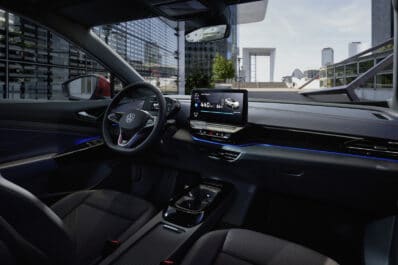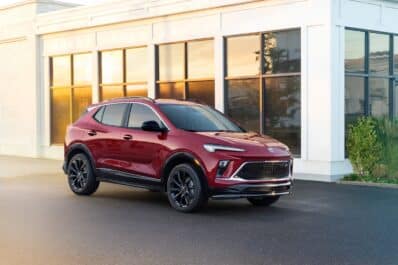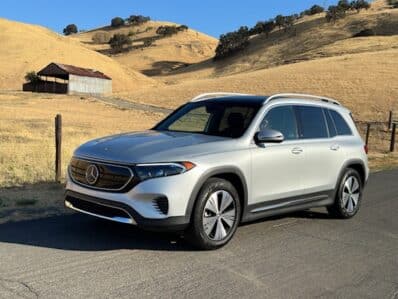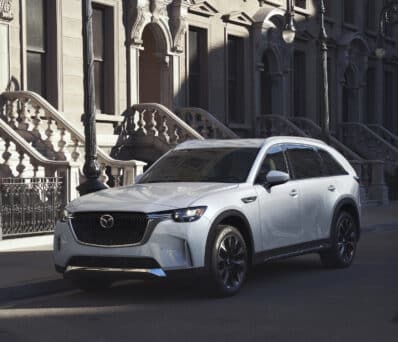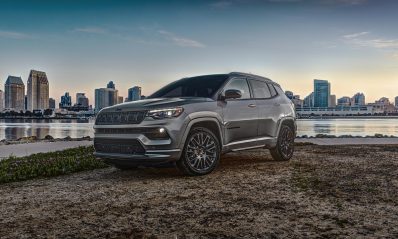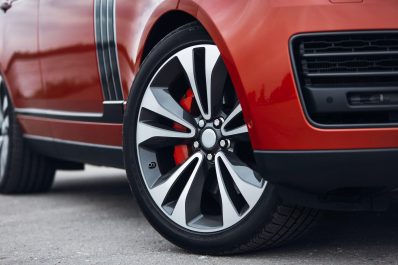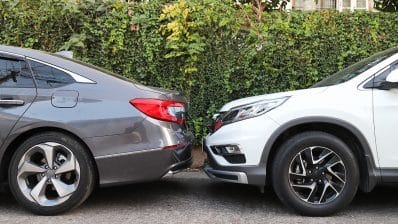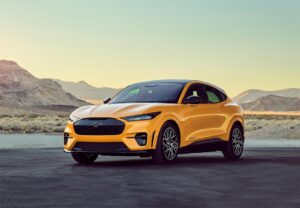
Ford is hoping history will repeat itself with the formal sales launch of the Mustang Mach-E this month. The original pony car was a runaway hit when it debuted more than a half-century ago and there’s no question that the all-electric model has generated plenty of buzz since it was unveiled at the 2019 Los Angeles Auto Show.
Even some competitors are quietly rooting for Ford’s first long-range battery-electric vehicle. With the exception of Tesla, no other BEV manufacturer has yet generated widespread public interest, but for Tesla. A successful launch of the Mach-E would show that there’s room for real competition – and that the battery-car market is finally gaining some much-needed momentum. That would be good news considering the hundreds of billions of dollars the industry collectively plans to spend to on EVs through mid-decade.
The real question, as I headed out to drive the Mach-E for the first time was whether Ford had finally come up with a serious alternative to Tesla — in particular, the Model Y?
(Ford powers up its electric pony with Mustang Mach-E GT performance edition.)
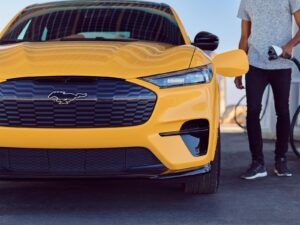
Overview: From Ford’s perspective, the new Mustang Mach-E is significant in a variety of ways. The automaker’s original battery-car offerings, such as the Focus EV, had little appeal to anyone but the most green-minded buyers. The new Mach-E aims to broaden the potential market. Not only can it manage as much as 300 miles on a charge, but also it delivers the sort of sporty acceleration and ride dynamics the Mustang name suggests.
It’s also got the higher seating position, roomy back seat and four doors that buyers crave in today’s SUV-crazed market. That said, as the first “brand extension” ever for the Mustang nameplate, the Mach-E has run afoul of some traditionalists. But few of those diehards were expected to buy a BEV anyway.
There are other pluses that Ford hopes will help sell the new offering, including an array of high-tech features, like the laptop computer-sized touchscreen infotainment system and the ability to download software upgrades and fixes using smartphone-style over-the-air updates. Among other things, that will include the semi-autonomous driving system Ford expects to launch next year.
“… Buyers should be aware that the sportiest version of the new battery-car, the Mach-E GT, won’t reach market until mid-2021 ….”
But, taking advantage of the incredible torque BEVs can deliver, even the mid-range, twin-motor model will launch from 0 to 60 in around 4.5 seconds.
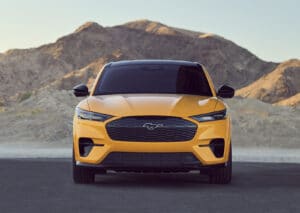
Exterior: You can feel like you’re in a straight jacket when it comes to redesigning an icon. The Ford team knew they had to hew closely to the original — or, at the least, make it look like the Mach-E is just a classic Mustang on steroids.
Overall, they did a solid job. The new battery car picks up a number of key design cues, including the sequentially flashing rear taillights and what, at first glance, appears to be a steeply raked roofline. But there is, as the art community would put it, plenty of trompe l’oeil elements clearly meant to fool the eye.
With no engine up front – the battery pack and motors housed beneath Mach-E’s load floor – the product development team could repurpose space up front for a larger passenger compartment. That said, they used subtle tricks to make it look like the BEV’s hood was as long as a classic Mustang. Similarly, by using a sort of two-tier design, the roofline looks a lot lower and more coupe-like than it really is, without actually limiting passenger headroom.
To my own eye, the one week spot is the design of the “grille.” While the nose of the Mach-E is meant to pick up on classic Mustang cues, aerodynamics had to play a significant role here, wind resistance not only impacting performance but also battery range. EVs don’t need as much air under the hood as a gas-powered vehicle so most either seal off the grille or eliminate it entirely. The Mach-E GT coming next year substitutes a textured pattern that retains a conventional, grille-like pattern look The rest of the line, however, opts for a smooth, plastic fascia that is the weakest part of the electric SUV’s design.
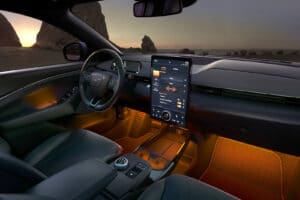
One other detail of note: unlike a number of other new BEVs that use pop-out door handles to reduce wind resistance, Mach-E designers eliminated handles entirely. With the “E-Latch” system, tap a touch sensor and the doors pop open, letting you pull them the rest of the way with small grab hooks.
Interior: The Mach-E’s cabin features a cleanly minimalist look, though it does pay homage to the double-cowl layout of the classic Mustang. There’s one thing that you won’t find in the coupe: plenty of storage, the floating, flip-up armrest concealing space large enough for a purse or bag.
There’s SUV-like room for five passengers and it’s relatively easy to get in and out of the back seat. The Mach-E features 29.7 cubic feet of cargo space, jumping to 59.7 cf. And, if that’s not enough, there’s a a roomy “frunk” under the hood big enough for a small roller bag — and sealed so a motorist could load up with ice and beverages for a tailgate party, with a drain at its base, of course.
While there are hints of traditional Mustang, the overall layout of the cabin puts an emphasis on Mach-E’s high-tech features. There’s a moderate-sized floating screen visible through the steering wheel that replaces a conventional gauge cluster. The layout and color changes when you switch between the various driving modes.
Virtually all other displays, knobs and switches have been replaced by a portrait-oriented, 15.5-inch touchscreen
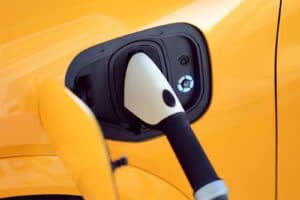
that dominates the instrument panel. Conceptually, it resembles what Tesla uses in its various models though it seems a bit easier to get familiar with. The system runs a modified version of Ford’s new Sync4 infotainment system. The Mach-E screen can be operated much like a smartphone, with taps, swipes and punches – or using verbal commands. It is nearly as good at responding to natural-speech as voice assistants like Amazon’s Alexa.
The system also offers a variety of special functions designed specifically for the EV, among other things, helping a motorist plan a route that will ensure there are charging stations along the way.
(Ford cutting price of Mustang Mach-E by $3,000.)
Powertrain: By mid-2021 Ford will offer three distinct powertrain options for the Mustang Mach-E, including the GT version that will pair twin 210 kilowatt motors, one on each axle. Because of electronic limitations, horsepower peaks at a nonetheless impressive 480, with torque coming in at 600 foot pounds. That’s enough to hit 60, Ford estimates, in 4 seconds. Earlier this month, the automaker announced a new Performance Edition that will churn out a full 480 hp (or 358 kilowatts) and 634 lb-ft of torque – and cut launch times to around 3.5 seconds.
Unfortunately, I won’t get a chance to test out either version of the Mach-E GT until next year, but I did get some time behind the wheel of both the base and mid-range model. The entry version still makes a sporty 250 hp and 300 lb-ft out of its single rear motor.
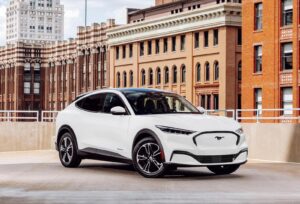
The step-up edition – in which I spent most of my time driving – adds a second, 50 kilowatt motor up front. That not only boosts acceleration but provides a through-the-road all-wheel-drive system. Translation: no center tunnel to carve into cabin space. How much power goes to the pavement depends upon whether you opt for the standard or extended-range battery. The latter not only delivers 300 miles per charge but a more sporty 346 hp and 428 lb-ft. You’ll hit 60 in around 4.5 seconds, making this version of the Mach-E quicker than a comparable Porsche Macan.
Technology and Safety: That big touchscreen anchors everything, serving as the car’s command center. But Ford’s development team has worked to let you integrate the Mach-E seamlessly into the rest of your digital life. That starts with the Phone-as-Key system that lets a driver to leave the traditional key fob at home and use their smartphone to enter and even run the battery-electric car. The vehicle knows a lot about you and automatically retrieves your personal settings. Meanwhile, you can provide additional digital keys to friends and family.
The Ford app, meanwhile, allows you to remotely start the car and, if it’s hooked up to a charger, pre-condition the cabin so you don’t waste battery power heating or cooling it up after taking off. You can trigger charging or set the time you prefer – useful if connected to a home charger that gets discounted energy at a particular time of day.
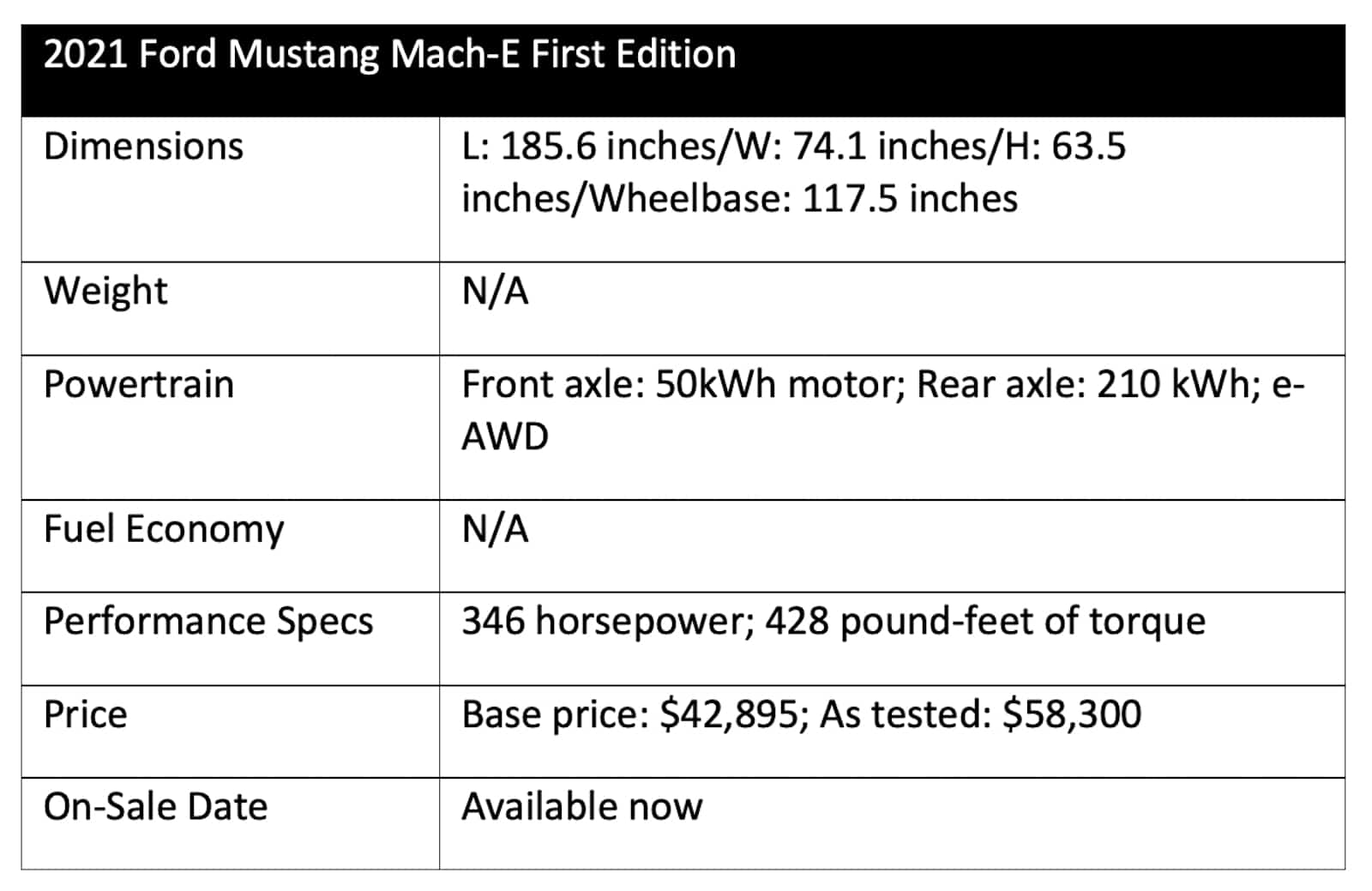 You can pre-select a destination and the Sync system will not just plot out a route but even lay out recommendations for where to stop and recharge, if necessary, along the way.
You can pre-select a destination and the Sync system will not just plot out a route but even lay out recommendations for where to stop and recharge, if necessary, along the way.
For audiophiles, the Mach-E offers an upgraded Bang & Olufson sound system with speakers that appear to float inside the cabin.
As you’d expect, the Mach-E comes with an extended array of advanced driver assistance systems, such as forward-collision warning with automatic emergency braking and blind-spot warning.
The electric Mustang is the first Ford to permit essentially all of its onboard software to be updated over-the-air. Expect to see that used for fixes – today, almost half of all recalls are software related. But Ford also plans to use the system to update and add new features. Next year that will include its new hands-free Active Drive Assist system. Eventually, it may also offer the ability to purchase new functions or download entertainment.
Drive Impressions: If you’ve not driven the latest generation of battery-electric vehicles you could be in for a surprise. As you’d expect, they are virtually silent but, unlike earlier BEVs, vehicles like the Ford Mustang Mach-E are finally taking advantage of the fact that electric motors make tremendous off-the-line torque.
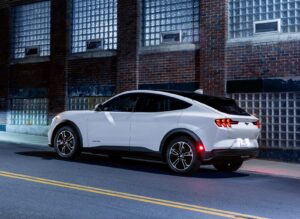
I was reasonably pleased with the sportiness of the base, single motor Mach-E, but the mid-range, twin-motor version should more than satisfy even serious performance-minded buyers. Slam on the throttle and you’ll immediately sink into your seat, and the sense of thrust continues right up through freeway speeds. Along the way you might notice the absence of any shifts, as the Mach-E – like most current BEVs – uses a single-speed transmission.
The Mach-E offers three distinct driving modes: Whisper, Engage and Unbridled. They step up the performance factor, as their names suggest. They also reconfigure the gauge cluster and come complete with unique soundtracks. Whisper mode takes advantage of the near silence of electric motors. You’ll hear a bit of tire and wind noise but Ford has done a good job of quieting the cabin down. Engage and Unbridled amp up the artificial soundtrack offering an alternative to traditional engine noises. Gimmicky, perhaps, but I found it nice to have some sort of sound geared to the vehicle’s performance.
The Mach-E also allows you to increase brake regeneration – the amount of energy the recaptured during braking and coasting as current – sending it back to the battery pack. This has a dual purpose. Not only does it increase range but it also functions as if you were downshifting. So, you can “one-pedal,” simply lifting off the throttle, say, to slow for traffic or as you enter a corner.
There’s a lot of mass to the electric SUV, and you do feel it a bit. But Ford engineers have done a good job of enhancing the overall ride dynamics. The Mustang Mach-E is a lot of fun to drive hard, willingly letting you flog it around corners.
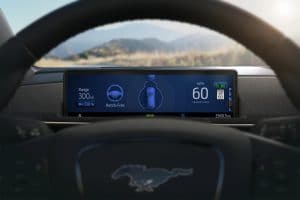
My only serious complaint: overly grabby brakes. I’m hoping this will be addressed before cars roll into showrooms, as Ford officials said they would try to do. But the over-the-air software updates would let them deal with this issue later, if need be.
(Ford will let you customize your new Mustang Mach-E before taking delivery.)
Wrap Up: When work began on a long-range electric vehicle, Ford started out working up a bland and boring product that likely would have been dead on arrival. Luckily, senior management rethought that strategy and sent the development team back to their digital drawing boards. Good thing. The 2021 Ford Mustang Mach-E is pretty much spot on, delivering all the things that you would expect from a vehicle sharing the pony car’s badge.
It’s good looking, sporty and fun to drive. It also delivers solid range and reasonably quick recharges. The overall look is appealing, both inside and out. And the electric SUV is loaded with appealing new technologies. Bottom line, it is every bit the serious competitor to the Tesla Model Y that Ford needed to deliver.
It’s too early to see how the market will respond – though Ford claims the Mach-E First Edition quickly sold out. What’s clear is that this is the sort of product that could win over lots of folks who never thought they’d want an EV, at least until now. And for those who do want an all-electric SUV, Ford’s long-range offering is ready to directly take on the king of the EV hill.



